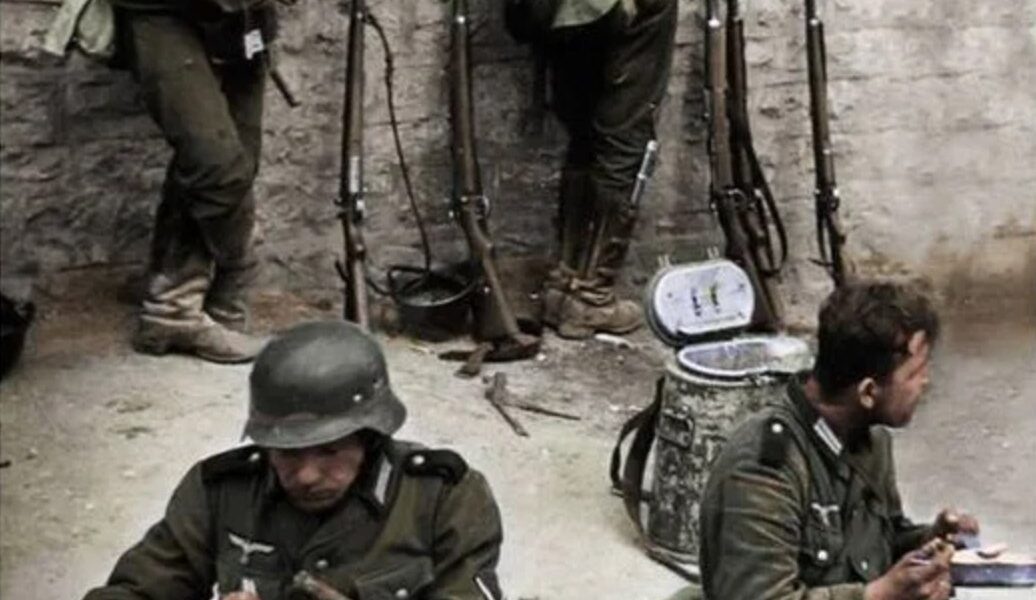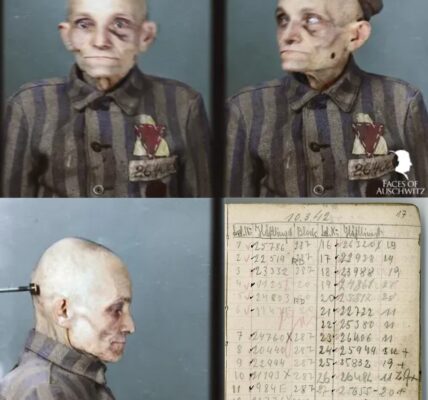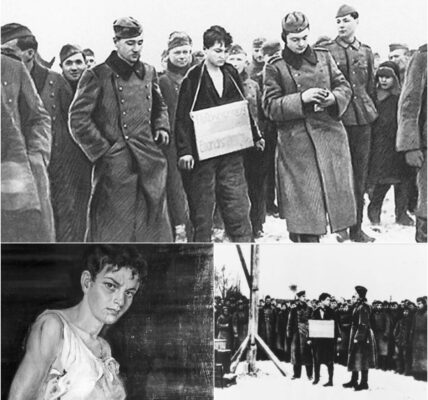Amazingly colored images of World War II bring the war to life for today’s viewers _en

Many thanks to Doug Banks and his team—the masters of colorization. The beauty of these colorized images is that color allows you to recognize and study even the smallest details. These are images our ancestors saw. It must have been strange for them to experience the war in color instead of seeing it recorded in black and white.
Don’t click on their page—you’ll become addicted to their work. It’s the research they do for each image that turns the captions themselves into a history lesson. Facebook page here: Colorized-Photos.
Assault troops of the U.S. Army’s 2nd Battalion, 165th Infantry Regiment, 27th Infantry Division land at Yellow Beach on Butaritari Island at 10:40 a.m. on November 20, 1943
Behind the tanks of the fourth and fifth waves came the troops of the 2nd Battalion, 165th Infantry Regiment, in LCVPs. Like the tank transporters before them, these also grounded on the reef. After a brief hesitation, the men stepped into knee-deep water and began their slow journey to shore.
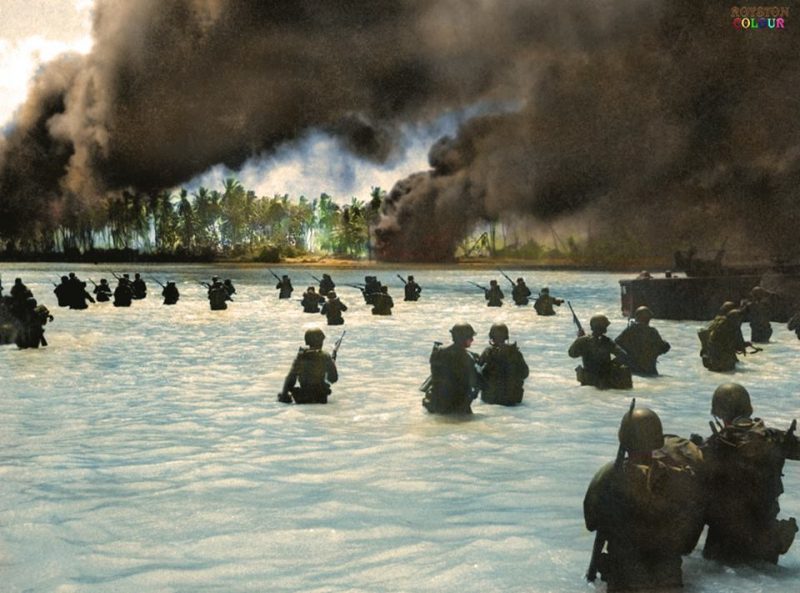
The intensity of enemy fire increased. Radios, flamethrowers, rocket-propelled grenades, and other equipment were soaked or lost. Although the troops were positioned close together in the water, they escaped with few casualties. The fire was mostly fired deep in the water and was inaccurate. Only two were killed, no one wounded.
(www.ibiblio.org) (Photo source – US National Archives) (Colored by Royston Leonard from Great Britain)
During World War II, Allied forces, primarily the Australian 6th Division, captured Tobruk on 22 January 1941. The Australian 9th Division withdrew to Tobruk after the fighting at Er Regima and Mechili to avoid encirclement, reaching Tobruk on 9 April 1941, where protracted fighting against German and Italian forces ensued.
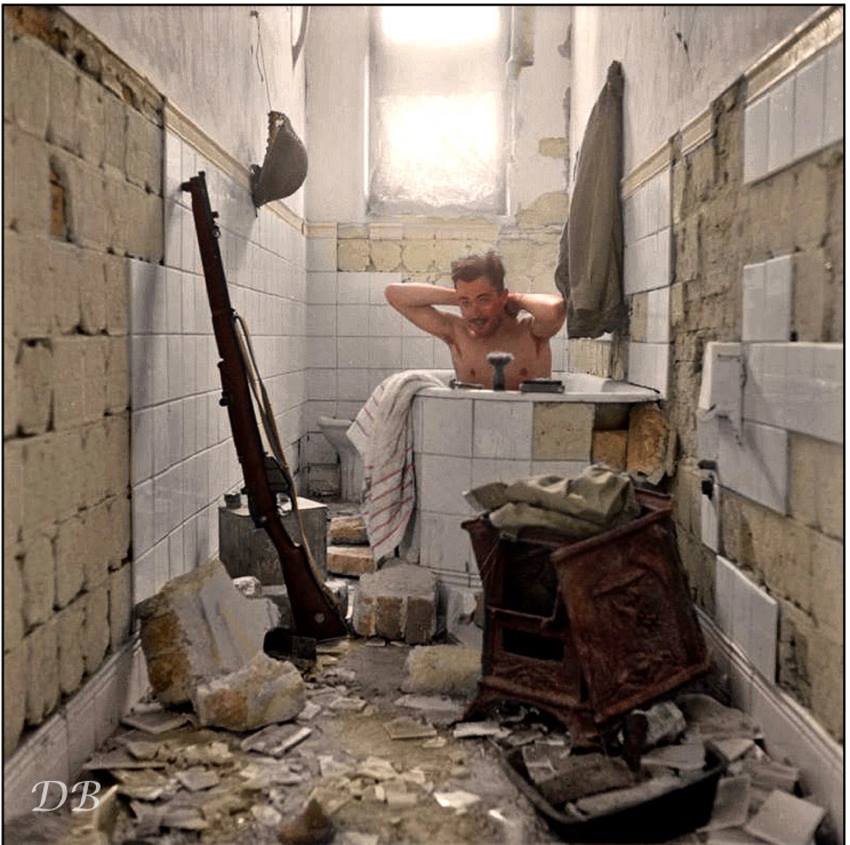
Although the siege was lifted by Operation Crusader in November 1941, a renewed offensive by Rommel the following year resulted in Tobruk being captured in June 1942 and held by the Axis forces until November 1942, when it was recaptured by the Allies. (Photo source – © IWM E 8439) No. 1 Army Film & Photographic Unit – Lt. William G. Vanderson.
Photographer Lt. William G. Vanderson was taken prisoner of war during the North African campaign and released from Oflag 79 in Braunschweig after the war. (Colored by Doug)

The 535th AAA AW (Anti-Aircraft Artillery Automatic Weapons) Battalion was part of the 99th Infantry Division, also known as the “Checkerboard Division” because of its shoulder patch.
The 99th Division was deployed for the first time on November 9th and assumed the defense of the nearly 30-kilometer-long section north of the Rur River between Schmidt and Monschau. After defensive patrols, the 99th Division probed the West Wall on December 13th, encountering heavy resistance. At the end of 1944, it was nicknamed “Battle Babies” because it had not yet participated in combat.
The division’s inexperienced troops found themselves on the northern shoulder of the Battle of the Bulge on December 16. Although battered and partially encircled, the 99th Division was one of the few that did not give in to the German attack and held its positions until reinforcements arrived.
On the 19th, the lines were withdrawn to form defensive positions east of the Elsenborn Ridge. Here, the unit withstood heavy enemy attacks. From December 21, 1944, to January 30, 1945, the unit engaged in aggressive patrols and re-equipment. On February 1, it attacked toward the Monschau Forest, conducting cleanup and patrols there until February 13, when it was relieved for training and rehabilitation.

A Navajo U.S. Marine communicates via radio on the Pacific battlefield of World War II.
In the 20th century, code talkers were people who used obscure languages for secret communication during wartime. Today, the term is most often associated with US soldiers who used their knowledge of Native American languages to transmit encrypted messages during the World Wars.
In particular, there were approximately 400–500 Native Americans in the United States Marine Corps whose primary role was to transmit secret tactical messages.
Code talkers transmitted these messages over military telephone or radio networks using formally or informally developed codes based on their native languages. Their service improved communications in terms of encryption speed at both ends during front-line operations during World War II.
The name “Code Talker” is closely associated with the bilingual Navajo speakers recruited by the Navy specifically for its standard communications units in the Pacific during World War II. However, the pioneering work of code talking was done by the Cherokee and Choctaw Indians during World War I.
Other Native American code talkers were employed by the U.S. Army during World War II, including Lakota, Meskwaki, and Comanche soldiers.
Postwar recognition:
The Navajo code talkers received no recognition until the operation was authorized in 1968. In 1982, the code talkers received a certificate of recognition from U.S. President Ronald Reagan, who also declared August 14, 1982, “Navajo Code Talkers Day.”
On December 21, 2000, the U.S. Congress passed Act 106-554, 114 Statute 2763, which President Bill Clinton signed into law. This awarded the Congressional Gold Medal to the original 29 Navajo code talkers of World War II and a Silver Medal to each person who qualified as a Navajo code talker (approximately 300).
In July 2001, U.S. President George W. Bush personally presented the medal to four living original code talkers (the fifth living original code talker was unable to attend) at a ceremony in the Capitol Rotunda in Washington, D.C. Gold medals were presented to the families of the deceased 24 original code talkers.
On September 17, 2007, 18 Choctaw code talkers were posthumously awarded the Texas Medal of Valor by the Adjutant General of the State of Texas for their service in World War II.
On November 15, 2008, President George W. Bush signed the Code Talkers Recognition Act of 2008 (Public Law 110-420). This Act recognizes every Native American code talker who served in the U.S. Armed Forces during World War I or World War II (except for the already honored Navajo) with a Congressional Gold Medal, individually designed for each tribe.
The gold medals were to be retained by the Smithsonian Institution, and each code talker or surviving family would receive a duplicate silver medal.
(Colored and researched by Paul Reynolds.)
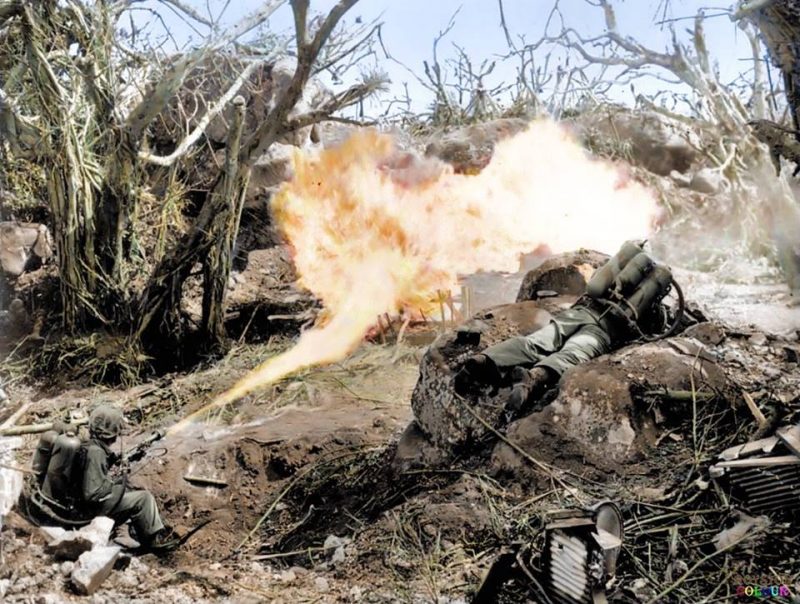
On the left is Pvt. Richard Klatt of North Fond Du Lac, Wisconsin, and on the right is Pfc. Wilfrid Voegeli of Kansas.
Pvt. Richard Adolph Klatt (left / Company “I,” Headquarters Platoon): Killed a few days later. (1926–1945) At the age of 19. Pfc. Wilfrid Marcus Voegeli (right / 1st Platoon): Awarded a Bronze Star for his actions on Iwo Jima. (1925–2001).
Marine Corporal Jim Shriver served as a Browning Automatic Rifle (BAR) soldier in Company I, 3rd Platoon (42 men), 3rd Battalion, 28th Regiment, 5th Marine Division (3/28). Jim and his unit disembarked on Iwo Jima at approximately 12:10 p.m. on February 19, 1945 (D-Day).
On February 20, 1945 (D+1), Jim Shriver was above and behind the two men (see photo), slightly to the right and about 20 to 30 meters away. Jim had his BAR rifle aimed and was firing at the cave entrance where the two flamethrowers met. Jim said the photographer must have been very close to him, but didn’t see him.
John Overmyer, Pharmacist’s Mate (PhM) of 2nd Platoon (now deceased), said he encountered Klatt shortly after his flamethrower was hit and burst into flames.
John went into some detail, saying that Klatt had suffered terrible burns, and John hadn’t been able to do anything. He couldn’t even pour water on his burns because his entire supply had been used up.
(Photo source: USMC). (Colored by Royston Leonard of Great Britain)

It had made an emergency landing behind Australian lines near El Alamein and was loaded onto a transport aircraft for transport to the RAF workshops for examination by experts. Other German aircraft attempted to destroy it after landing to prevent the publication of secret technical developments. Lieutenant Gerhard Mix remained unharmed and was taken prisoner of war. This Bf. 109 is camouflaged according to RLM 78/79, with a typically undefined color marking in the center of the fuselage (although somewhat lower than usual).
Markings include a white spinner and collar, a white fuselage band and wingtips, and a yellow lower cowling.
The number “5” and the crossbar are outlined in yellow and black. The squadron crest, the “Berlin Bear,” is painted on both sides of the paneling.
(Photo source: Australian War Memorial). (Colored by Richard James Molloy from Great Britain). www.tig.uk.net
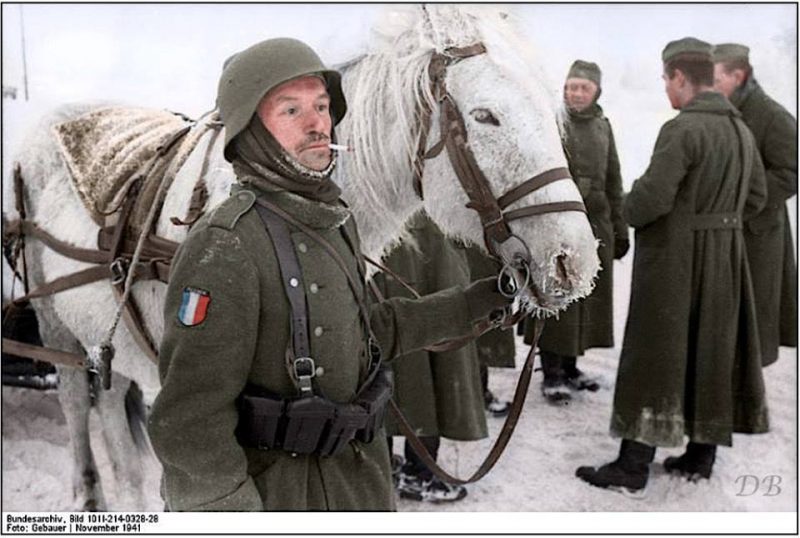
Soldiers of the French Volunteer Legion of the Wehrmacht in Russia, November 1941.
The Légion des Volontaires Français (LVF), or Infantry Regiment 638 as it was known to the Germans, was formed in July 1941. It was sent to Debica, Poland, for training and remained there until October before being assigned to the 7th Infantry Division on the Eastern Front. It suffered heavy losses during the Soviet Winter Offensive, and the 2nd Battalion was almost wiped out. However, a 3rd Battalion was formed from new volunteers (including about 200 Africans, mainly from Algeria).
After these losses, the unit operated as individual battalions rather than as a unified unit in the fight against the partisans. It continued fighting against the partisans in 1943, but was again deployed as a unified unit when all battalions were assigned to the 286th Security Division.
In September 1944, it merged with the French SS Volunteer Assault Brigade to form the Waffen Grenadier Brigade of the SS Charlemagne. (Source – axishistory.com). (Photo source – Bundesarchiv_Bild_101I-214-0328-28)
(Colored by Doug)

February 20, 1945 (D-Day+1) “…my head is killing me and this guy is taking my picture.”
As soon as they landed, the unit was constantly harassed by enemy artillery, mortar, and machine gun fire. A fellow Marine lost his composure and fired small bursts in all directions until O’Neil picked up his rifle. “It wasn’t bad enough that we could barely move, and then one of our leaders started shooting in all directions. We had to take his rifle away from him.”
Shortly thereafter, they came under fire. They were concerned by the large number of Japanese soldiers advancing toward them and noticed that their .50 caliber machine gun had been disabled by enemy fire. The firefights at the front were fierce, and the machine gun seemed a better option than the M1.
They had turned on us. We fought, and men were falling. At one point, we noticed they’d taken out our machine gun. The M1 was a good rifle, and I know what they teach you about shooting, but there will be nights when you sleep pretty sore. I swear we could have shot the men behind the trees on those islands. We figured the only way we could get off the island was behind the machine gun, and decided we might as well make it. We moved the men and started firing with the rifle. The shells we fired were half an inch in diameter. We were engaged in a pretty tough fight and lost a lot of good men. After that, we took turns fighting our way the rest of the way.
One evening we were firing the machine gun, and the baby was getting hotter and hotter. They just kept coming at us. All I can say is, we were lucky our division had spare barrels with us.”
They also helped repel several banzai attacks that took place on the island toward the end of operations. O’Neil and Dalphonse served as machine gunners throughout most of the operation.
Nick also cornered a Japanese officer as they fought their way through the undergrowth. He finally had his rifle pointed at him. O’Neil looked around and caught sight of his comrade. Nick said it seemed like an eternity, but he saw that the soldier had some rank and thought he should be brought back for questioning. So they brought him back to their operations commander.
On Iwo Jima, heavy fire broke out as they made their way up the beach. O’Neil was hit by mortar fire. Nick bandaged him and helped him back to the boat that would take him to the hospital ship. “Shells were flying everywhere, and suddenly I saw ‘Plug’ running back with both hands over his face,” he added. “So I grabbed him, saw he’d been hit, and brought him back to the landing craft.”
After losing their platoon leader, Staff Sgt. Dalphonse eventually took command of the remaining men.
Bob O’Neil’s account:
A mortar attack hurled him into the air, shattering his head and face.
He recalled spitting blood and teeth as Nick Dalphonse hastily bandaged his head and helped him back to shore to reach a boat to a hospital ship. Along the way, a naval photographer snapped a photo of Dalphonse supporting his wounded, tall comrade.
Bob O’Neil’s wife, Betty, said her husband once told her how angry he was at being photographed at that moment. She recalled, “He said, ‘I have a headache and this guy is taking my picture?’ That’s why his hand is clenched in the photo.”
(The photographer was Corporal Eugene Jones, also of the 4th Division.) Robert O’Neil died in 2002 at the age of 78. Nick Dalphonse was 91 in 2014 (and may still be alive).

The man on the left wearing the scarf is F/L Colin MacFie, and the man with his back to the door is F/L Hugh “Cocky” Dundas, both from the visiting 616 Squadron. (Photo source – © IWM CH 1461). Official Royal Air Force Photographer – Devon SA (Mr.).
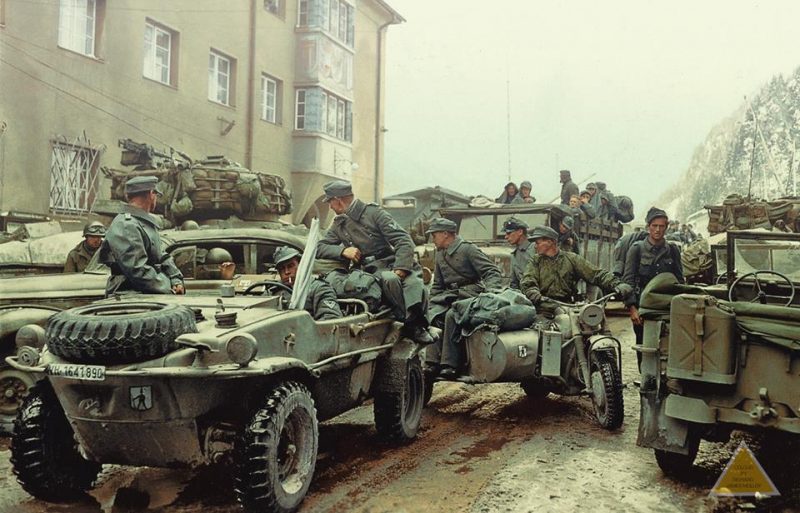
(The emblem of the 278th Infantry Division was the black figure of a Pomeranian grenadier with a musket, surrounded by a shield.) The 278th Infantry Division occupied defenses near the Brenner Pass. It surrendered to the 5th and 7th U.S. Armies in May 1945. Originally assigned to the LXXVI Panzer Corps to defend the Gothic Position, it was reorganized into a Volksgrenadier Division after suffering heavy losses in early 1945. Later, it was assigned to the 1st Parachute Infantry and defended the Brenner Pass, where most of the division was encircled; the remainder surrendered on May 2, 1945.
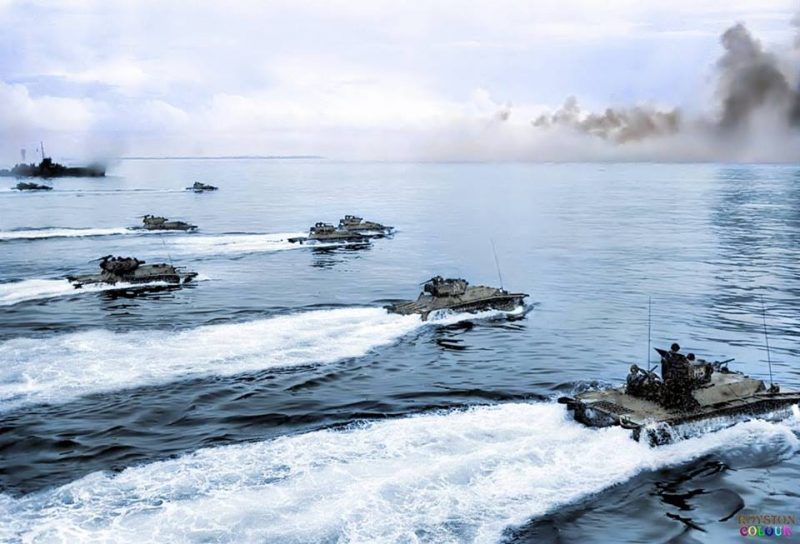
The amphibious tanks, with their turret-mounted cannons, advanced after heavy aerial and naval bombardment. Army and Navy assault units stormed the coast of Peleliu on September 15, and on September 27, it was announced that organized resistance had almost completely ended.
Operation “Stalemate II” – The operation on Peleliu was codenamed “Stalemate II,” a name that seems ironic in retrospect, given the relatively optimistic outlook for the campaign. The primary task of securing the island was assigned to the 1st Marine Division, a unit composed largely of veterans who had already seen action on Guadalcanal and New Britain. The 1st Marine Division consisted of the 1st, 5th, and 7th Marine Regiments (Infantry) and the 11th Marine Regiment (Artillery Support). (AP Photo)
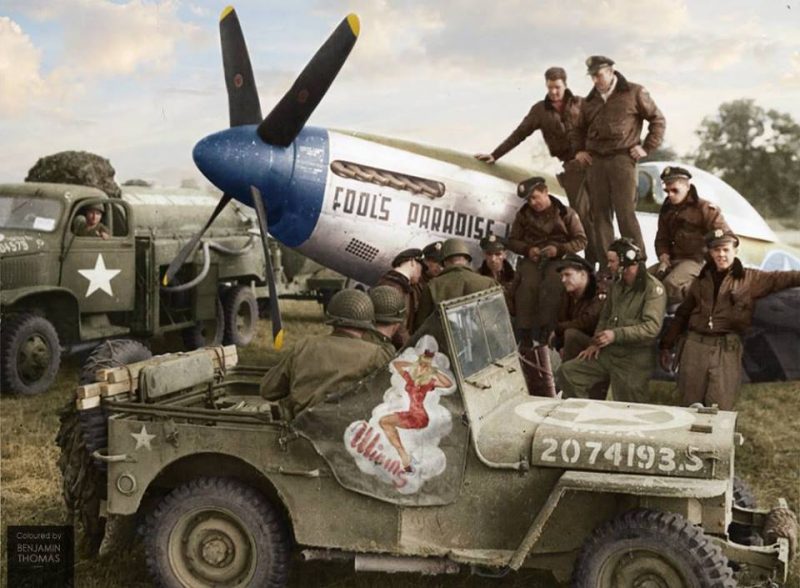
Evan M. “Mac” McCall was a squadron commander and served with Patton’s 3rd Armored Division as a ground anti-aircraft commander in a Jeep in France. (Note: We have not been able to confirm the correct color and content of the Jeep artwork, but we have used our knowledge of the “nose painting” of US aircraft from World War II to determine these colors. If anyone can help identify the colors or the name on the canvas, please let us know.)
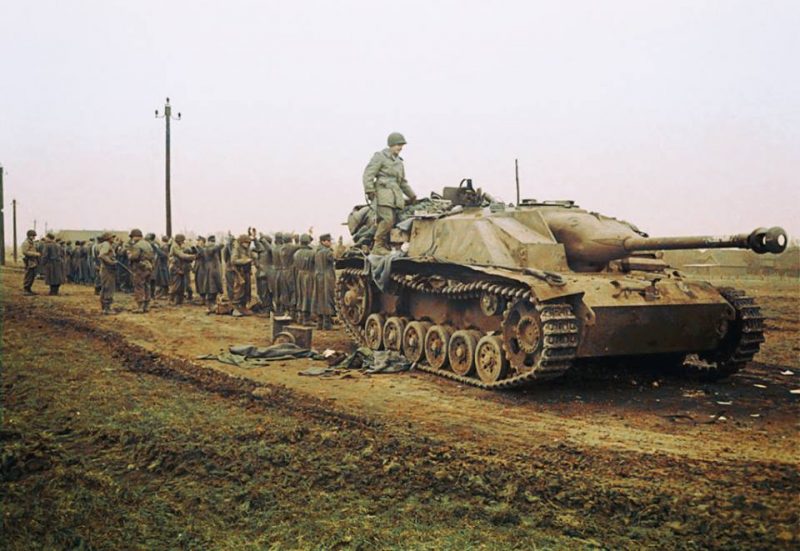
There is not much information on this, but what is interesting is the “nose art” on the pot blind (often called the sow’s head), which was added by the crew or perhaps by Allied soldiers.

F/Lt Pattison, from Waipawa, flew with Nos. 92 and 266 Squadrons during the Battle of Britain. He was shot down by a Bf 109 in September 1940 and severely wounded. He recovered and performed distinguished service during the war, for which he was awarded a DSO and a DFC. He died in 2009 at the age of 92. S/Ldr. “Reg” Joseph Cowan Grant DFC & Bar, DFM, from Woodville Nth Island, was appointed Wing Commander Flying of the Mustang-equipped No. 122 Squadron in early 1944.
On February 28, 1944, Grant embarked on a mission over the English Channel. Shortly after takeoff, his fighter’s engine failed in the clouds. After ordering the squadron to continue flying without him, he returned to base. As he cleared the clouds at an altitude of 300 meters, he parachuted, but was too low to properly deploy his parachute and crashed to his death.
Reginald William Baker of Dunedin was commanding officer of 487 Squadron, Royal Navy (RNZAF)
, and flew the Mosquito six times. On February 22, 1945, he was killed in action while conducting an armed reconnaissance mission over the Hamburg-Bremen coast. He was one of two Mosquitos shot down northwest of Hamburg. At 1:15 p.m., he crashed near Bevern, seven kilometers east of Elmshorn.
(Photo source – © IWM CH 8385). Official Royal Air Force Photographer – F/O Watkins

At the controls are 1st Sergeant Owen E. Henderson and 1st Lieutenant James Cox, both from C Company, 326th Airborne Engineering Battalion, 101st Airborne Division.
On May 4, 1945, the 101st Airborne Division “Screaming Eagles” liberated and took possession of this armored Mercedes-Benz 540 K Special Roadster, built in 1937, in Berchtesgaden in the Bavarian Alps. The car was a special order for Hermann Göring.
US Major General Maxwell Taylor used this Mercedes as a command vehicle in Germany until it was commissioned by the US Treasury Department in Washington, D.C., for display on a Victory War Bond fundraising tour across the US. The bond tour was very successful.
In 1956, the car was auctioned by the U.S. Army at Aberdeen Proving Grounds in Maryland, where it was sold to Jacques Tunick of Greenwich, Connecticut, for $2,167. In 1958, he sold it to the private collection of veterinarian Dr. George Bitgood Jr., who had it painted black and chrome-plated. Bitgood kept it privately and exhibited it only once, at the 1973 County Fair in Durham, Connecticut.
Following Dr. Bitgood’s death, “Blue Goos” was displayed by his family at the 101st Airborne reunion at Fort Campbell, Kentucky, in June 2002. The car was then sold to Carnlough International Limited of Guernsey, with the agreement to restore it to the condition in which it was found in Berchtesgaden.
(Colored by Patty Allison from the USA)
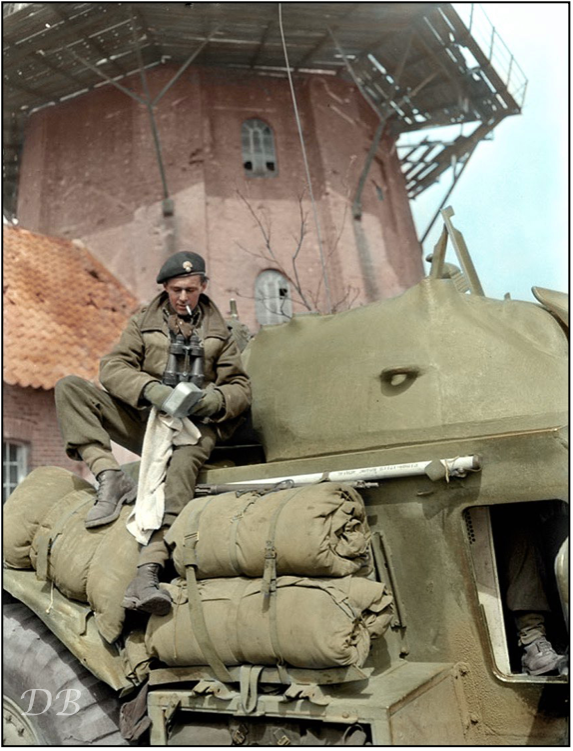
We suspect: This soldier is wearing a Canadian Grenadier Guardsman’s cap, and the CGG captured Bad Zwischenahn with the 18th Armored Car Regiment (12th Manitoba Dragoons). Therefore, the Staghound could belong to them and not to the Southern Alberta Regiment.
“…the Southern Alberta Regiment had attempted to cross the Aue to defeat the 2nd Division at Oldenburg. In the process, it lost five Shermans, four Stuarts, and an armored ambulance between April 15 and 19, but still fought its way through scattered infantry resistance. The loss of one of Valentine’s bridge-building tanks to a mine ended the advance on Oldenburg. A missed opportunity that the commanding officer later described as “the greatest disappointment of the war.”
Feeling stranded, the SAR found itself out of range of its own artillery, except for a few medium batteries. Therefore, it converted one of its squadrons to indirectly fire its Shermans’ 75mm guns to support the other two squadrons. The commander established another engineer platoon to reinforce the existing force and secured a company from the Lincoln and Welland Regiment, a squadron of Staghound armored personnel carriers from the 18th Armored Car Regiment, and a squadron of M-10 self-propelled guns to make the regiment self-sufficient.
As the advance resumed on April 17, the SAR had to cover a 19-kilometer front, and a new bridge-laying unit took them across the Aue. Another river, the Lethe, had to be bridged on the 19th. Resistance intensified, and isolated fighting outside Oldenburg continued until April 24, the last heavy day of fighting the regiment saw in World War II.
Reinforcements from the Lincoln & Welland and the Manitoba Dragoons were withdrawn, and the headquarters commander of the 4th Canadian Armoured Division refused a request from the commander for infantry—there were none left. The SAR was ordered to simply maintain contact with the enemy. This meant advancing through craters, mines, and booby traps after the Germans decided to withdraw from their positions.
To the left of the 4th Armored Brigade, the 18th Armored Car Regiment (12th Manitoba Dragoons) drove northwest toward Godensholt. Brigadier General Moncel noted that the roads prevented the simultaneous deployment of more than two tank squadrons, as only one squad at a time could fire directly at the enemy. Tactics focused on finding company targets 200 meters apart. The attacks were supported by individual tank squads, which were no more sophisticated than driving directly toward the objective. However, they were supported by good coordination with air support.
German resistance along the access roads to Bad Zwischenahn remained fierce despite their own losses (3,600 prisoners were placed in the 4th Division’s POW camps in April).” (Photo source – (Lieut. Christopher J. Woods / Canada. Department of National Defence / Library and Archives Canada / PA-144148).
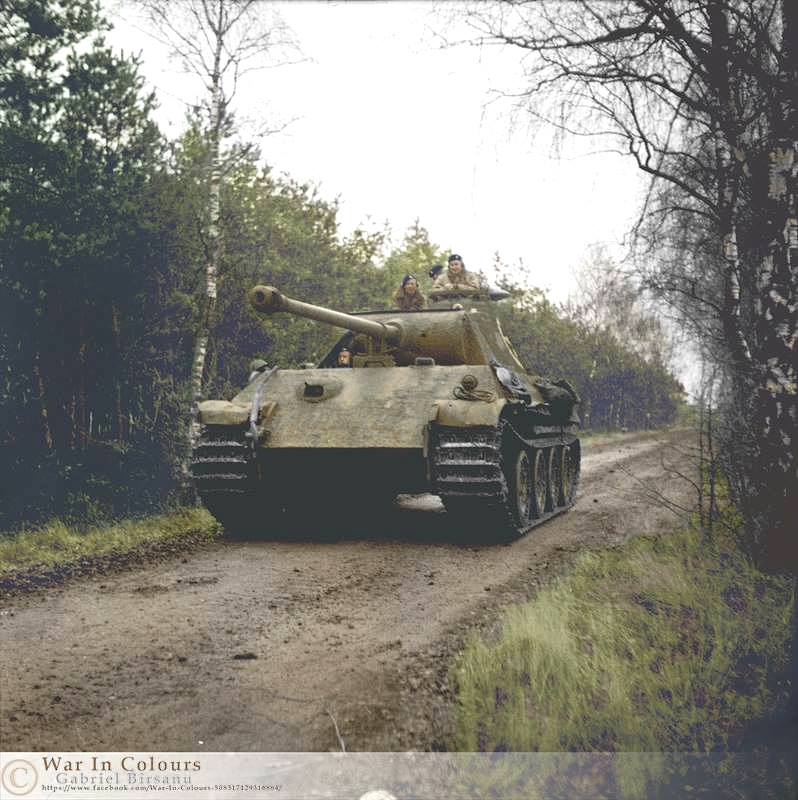
One of the best-documented cases is that of the Panther, which was renamed “Cuckoo.” The tank was found abandoned in a barn during the fighting around the village of Overloon. Before its capture, the tank belonged to the 2nd Armoured Brigade, 107th Infantry Regiment. The British tankers assigned the “Cuckoo” to the 4th Battalion, Coldstream Guards, along with their Churchills, apparently a staff unit. These staff tanks were all named after birds such as eagles and vultures; hence the name “Cuckoo.” To prepare the tank for its new owners, it received a fresh coat of paint, most likely the same khaki as the Churchills. The new drivers of the “Cuckoo” were impressed and pleased with their acquisition; in particular, they admired the high quality of the optics for which the Germans were known.
“Cuckoo” participated in the attack on Geijsteren Castle and subsequently took part in Operation Blackcock in January 1945. The goal of this attack was to drive the Germans out of a triangular area between the Dutch cities of Roermond, Heinsburg, and Sittard. “Cuckoo” was used in an attack on the town of Waldenrath, located in the southeastern part of this triangle. The winter was harsh, and the icy roads made progress difficult. “Cuckoo” both impressed and annoyed its new owners. While the Churchill tanks constantly skidded and got stuck on the icy roads, the Panther moved along smoothly, oblivious to the conditions the British tanks faced.
The tank saw action again during Operation Veritable, a campaign to clear the area between the Rur and Rhine rivers in Germany. During this operation, the British were involved in heavy fighting in the Reichswald, a wooded area inhospitable to tanks. Nevertheless, “Cuckoo” fought here for its new owners. Unfortunately, during this campaign, the Panther’s fuel pump failed and could neither be repaired nor replaced. The Coldstream Guards abandoned the tank and ended the war with their Churchills. (warfarehistorynetwork.com)
(Photo source – © IWM B 12187) Army Film and Photo Unit No. 5 – Sgt. Laing.

December 31, 1943: Mission
Target: Blockade Runner “ORSONE” (Ship Name)
Target Type: Transport
[Garonne Estuary], France
Target not found: The 384th Bomber Group (H) was flying as the low-level attack group of the Kampfgeschwader on today’s mission. The primary target was reportedly at or near the mouth of the Garonne River, which rises in the Pyrenees, flows northwest through Bordeaux, and empties into the Bay of Biscay. However, the target was not seen due to 10/10 cloud cover, while the secondary target was obscured by 8/10 cloud cover, so the formation returned without attacking. The bombs were mostly dropped in the English Channel. Due to weather and fuel shortages, most of the aircraft landed at other bases.
B-17F (41-24578) “ORSONE” landed with a bomb load off Kimbolton. Leo Teetman was born in Brooklyn to Polish parents and spent most of his life on the East Coast. He joined the Army in 1942 and was assigned as a gunner to the 384th Bomb Group, 547th Bomb Squadron, stationed at Grafton Underwood in Northamptonshire, Great Britain.
Leo completed 25 credited missions in the early stages of the bombing campaign, when the USAAF’s focus was on occupied Europe.
After the war, Leo settled in Connecticut, where he worked for a company that manufactured optical instruments. He married and had three children. Leo Frank Teetman (1922–1999).
(Colored by Doug)
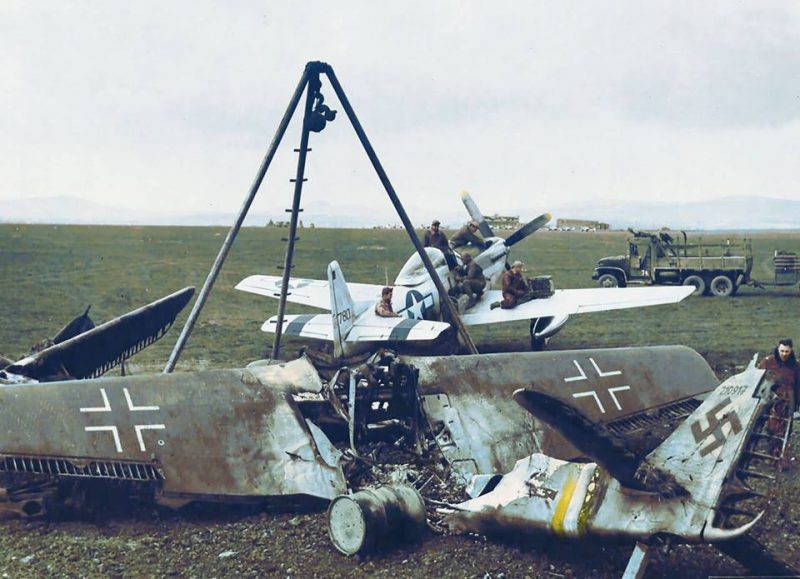
Around April 8, 1945, when the 345th Fighter Wing relocated to Ober-Olm. In the foreground is the wreckage of a Focke-Wulf Fw 190D-9 (W.No. 210917). It was recovered in December 1944 and appears to have been blown up by retreating German troops or by P-47 Thunderbolts from an earlier attack. (Official US Air Force Photo No. 080 307-f-3927O-037)
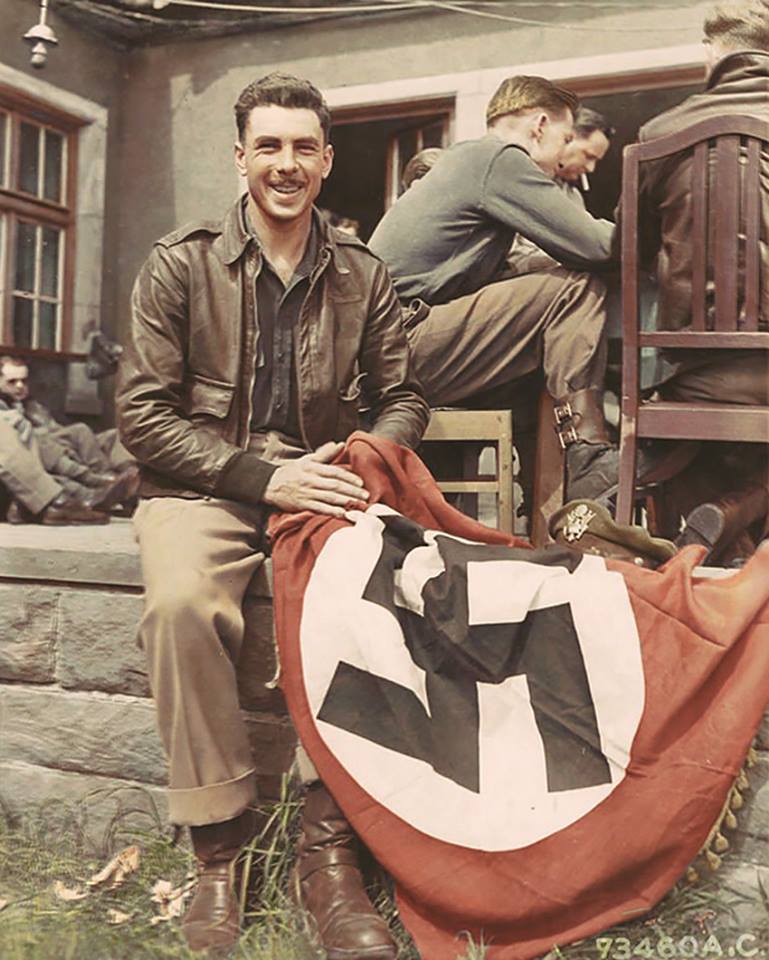
He was shot down and captured over Witzenhausen, Hesse, on March 31, 1945; he managed to escape on April 10 as American troops approached the prison camp. (Photo: April 17, 1945). Kenneth Edwin Neidigh of Spokane County, Washington.
September 27, 1923 – March 4, 2006.
(Colored by Richard James Molloy of Great Britain)
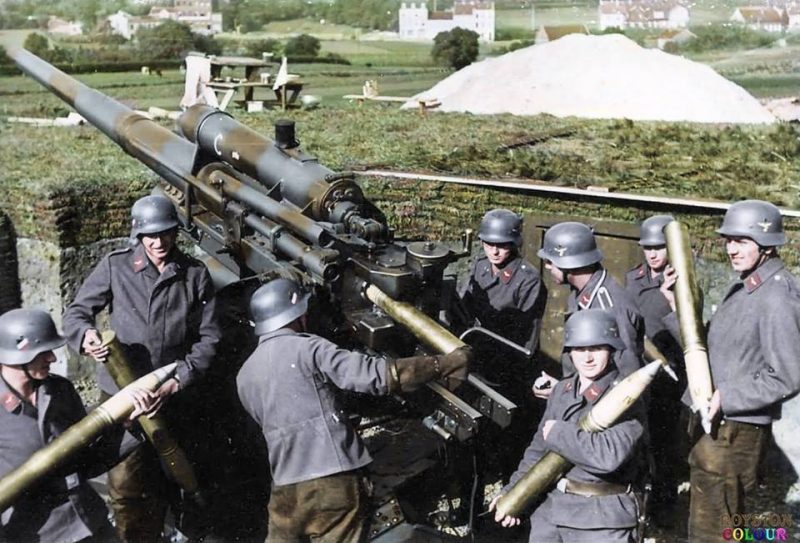
The 88 mm gun (Achtundzig) was a German anti-aircraft and anti-tank gun of World War II. It saw widespread service in Germany throughout the war and was one of the most recognizable German weapons of the war. The evolution of the original models led to a wide variety of guns.
The name applies to a number of guns; the first was officially called the 8.8 cm Flak 18, the improved 8.8 cm Flak 36, and later the 8.8 cm Flak 37. Flak is an abbreviation for “Flugzeugabwehrkanone,” meaning “anti-aircraft gun,” and was the original purpose of the Achtundzig. In colloquial German, the guns were commonly known as Acht-acht, an abbreviation of Acht-komma-acht centimeter (“8.8 cm”). In English, “Flak” became a general term for ground-based anti-aircraft fire.
The versatile carriage allowed the 88 to be fired in limited anti-tank mode on wheels and fully deployed in just two and a half minutes. Its successful use as an improvised anti-tank gun led to the development of a tank gun based on it. These related guns served as the primary armament of tanks like the Tiger I: the 8.8 cm KwK 36, where the abbreviation “KwK” stands for KampfwagenKanone (combat vehicle gun).
In addition to these Krupp designs, Rheinmetall later developed a more powerful anti-aircraft gun, the 8.8 cm Flak 41, which, however, was produced in relatively small numbers. Krupp responded with another prototype of the long-barreled 88 mm gun, which was further developed into the 8.8 cm Pak 43 anti-tank and tank destroyer gun and the turret-mounted 8.8 cm KwK 43 heavy tank gun.
